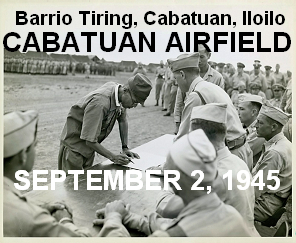
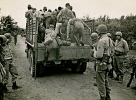

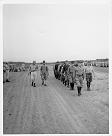


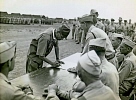
Col. Ryoichi Tozuka signs the surrender instrument
as Col. Raymond G. Stanton looks on.
Cabatuan Airfield
Barrio Tiring, Cabatuan, Iloilo
Panay Island, Philippines, September 2, 1945
|
|
- o -
|
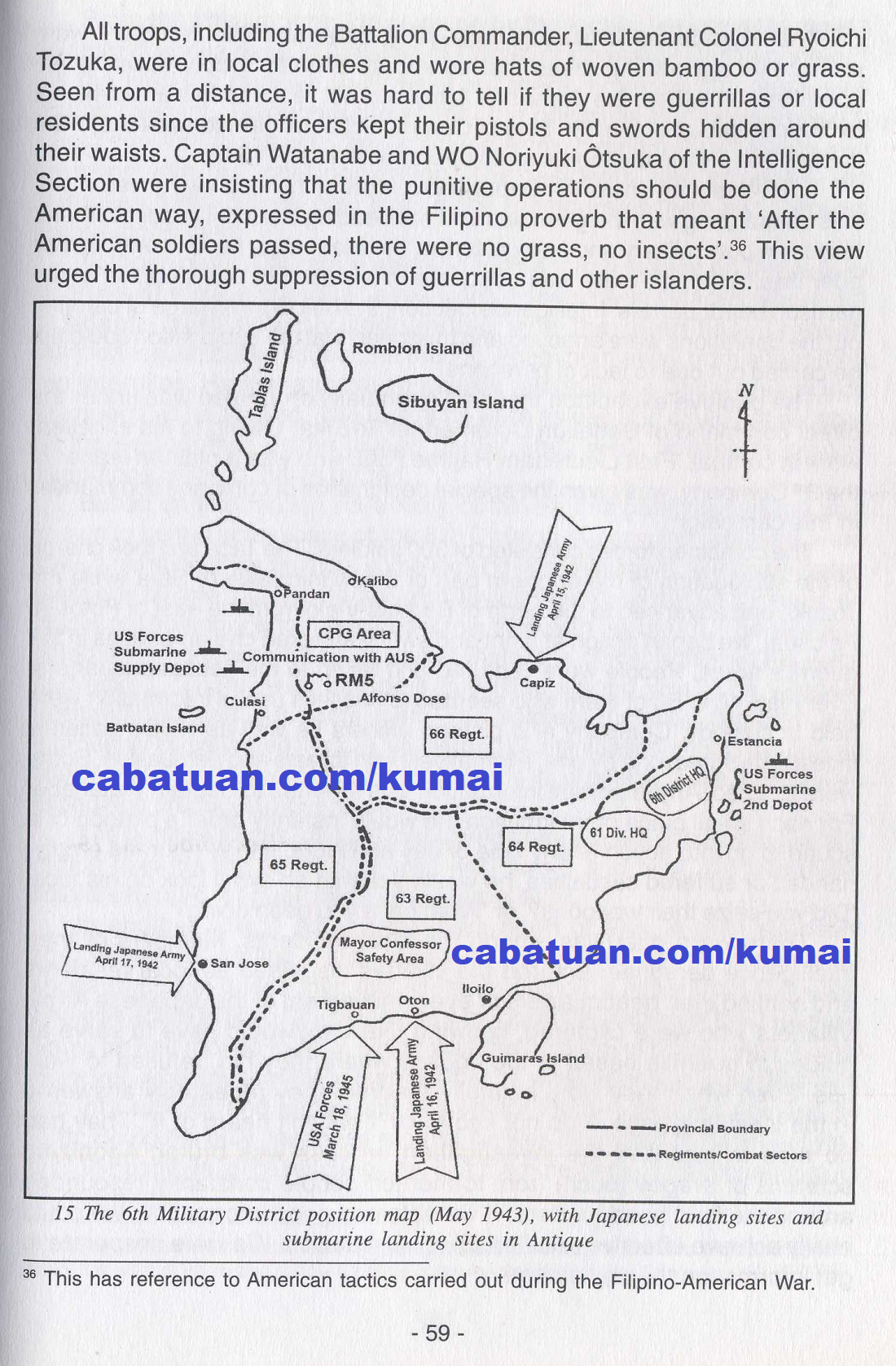
The 6th Military District position Map (May 1943), with landing sites and submarine landing sites in Antique. Page 59.
|
|
CHAPTER 4 – TORTURE
4.4 False allegiance of villages (September 7 to December 31, 1943)
After the punitive operations around the mountains of Bocari and the subjugation of Guimaras Island, the Tozuka unit returned to Iloilo City for a few days’ rest. By around September 7, 1943, another phase of the punitive expedition aimed at the northeastern area of Panay Island started. The target area included the towns of Ajuy, Sara and San Dionisio where Colonel Peralta’s headquarters for the 6th Military District, the 61st Division as well as the main headquarters of the 64th Regiment were located. Other targets were the 661st Regiment and the Coast Patrol Guard [sic.] in Capiz, and Tablas Island, and the 65th Regiment in Antique. These major expeditions lasted until the end of December.
All troops, including the Battalion Commander, Lieutenant Colonel Ryoichi Tozuka, were in local clothes and wore hats of woven bamboo or grass. Seen from a distance, it was hard to tell if they were guerrillas or local residents since the officers kept their pistols and swords hidden around their waists. Captain Watanabe and Noriyuki Otsuka of the Intelligence Section were insisting that the punitive operations should be done the American way, expressed in the Filipino proverb that meant ‘After the American soldiers passed, there were no grass, no insects? This view urged the thorough suppression of guerrillas and other islanders.
The target areas for subjugation–Ajuy, Sara, and San Dionisio–were well-known agricultural areas that served as a great supply base for the guerrillas. Until then, the Japanese Army had not reached this area, except for support group of the 63rd Line of Communications garrison unit that went through the area in the mopping-up operations in early 1943.
Jose Aldeguer, one of the Deputy Governors of the local civil government, was cooperating with the guerrillas and was leading the local residents there. Hence, in both military and political terms, the area was a haven controlled by guerrillas. Although there was adequate information of this situation at the garrison headquarters’ Intelligence Section, the officers in charge of carrying out the operations were annoyed and frustrated that the subjugation could not be carried out due to lack of personnel.
The punitive expedition that was eventually organized was under the direct command of Battalion Commander Tozuka. Owing to his excellent work in combat, First Lieutenant Hajime Fujii, who was a platoon leader of the 3rd Company, was given the special designation of company commander in this campaign.
The combined forces consisted of 300 soldiers. The Taga unit took charge of the subjugation of the northern part of the municipality of Sara while the Tozuka unit advanced to the north of Barotac Viejo from the east of Pototan. As usual, we began action at night and swiftly attacked civilian houses in the guerrilla areas. People were captured and taken to the field headquarters. Everyday, 40 to 50 of them who seemed to possess useful information were held in custody. Company and platoon officers as well as NCOs patiently investigated them one by one, alternatively with threats and persuasion. Some were tortured. Any important information was reported to Captain Watanabe. For each small piece of information, he would instantly order a platoon or a squad to go into action at any time of day and night. If they returned empty handed or suffered casualties, he would yell with an awful look on his face, ‘Did you seize their weapons?’ or ‘What have you been doing?’
There were guerrillas among the local residents. Members of their intelligence personnel entered the villages disguised as local residents and notified their headquarters of every movement of the Japanese Army. Villagers who were captured, knowing that they would have to serve as guides to guerrilla bases or the houses where they hid, refused to yield tips. Even when they were painfully tortured, they repeatedly answered in the local language, ‘I do not know’, or ‘I haven’t heard of it’. They had no time to rest and the investigation process was brutal. Agonizing screams of aragoy (ouch) from tormented people constantly resounded around the field headquarters. If we obtained good information, we could easily achieve effective results with few casualties. We were desperate to get information, by any means.
From the little information given up by the locals, we knew there was a major guerrilla base in the area of Dacal, northeast of Barotac Viejo. By the time the punitive units were led there, however, the place was already vacant. Throughout this time, the guerrillas had been avoiding direct confrontations with the Japanese Army, hiding their weapons and mingling with the local population. The residents also protected the guerrillas, risking their own lives since members of their own families were among them.
In those days, Captain Watanabe took a harsh stance on the people of areas where the guerrilla bases were, especially in villages where the residents were actively cooperating with the guerrillas. Through intimidation, threats and fear, he tried to wean them away from supporting the guerrillas. He first attacked a nearby village in the Dacal area where the guerrillas had bases. The residents were asleep and could not escape. Gathered together at the village center, they were obliged to pledge allegiance to the punitive forces.
Based on information previously obtained, this particular village was known to be the actual base of the 61st Division. Among the residents were quite a number of young men, some looking very intelligent. We investigated them one by one, but everybody kept saying they knew nothing. Finally, an officer got so angry and beheaded a few men with his sword. The villagers paled and shook with fear. Looking at them, the officer softened his voice–and asked, ‘There must be some guerrillas among you.’ The villagers hesitantly pointed out some men. The soldiers instantly captured and thoroughly investigated them. This method of intimidation and threat proved effective and we got more information from the local people. Thus, the punitive expedition produced more results.
The punitive forces, divided into several groups, advanced into the hilly region towards the south. Covered with sweat and dust, the Japanese soldiers hunted for guerrillas in the area of Ajuy.
In another village some kilometers north of Ajuy, a man suddenly approached us saying ‘I am Japanese’. Surprised by his unexpected was Shimoji, a fisher from Okinawa, was active in lloilo City before the war. Upon the landing of the Japanese as the hometown of his Filipina wife. However, when the people learned that he was Japanese, guerrillas took into custody and forced him to work for them–cleaning rice and so forth. Being the only Japanese around, he was subjected to harsh bullying until the punitive force rescued him. For the time being, I employed him as an interpreter.
As we approached Ajuy, 65 kilometers northeast of lloilo City, the hunt for guerrillas and the investigation of local residents became more and more harsh. After three and a half months of punitive operations, the guerrillas appeared to have been avoiding the Japanese Army. The punitive forces were not able to have any real battles with them and simply wandered around mountains and along rivers searching for guerrilla forces. The guerrillas seemed to have been watching us from a distance but kept away. Captain Kengo Watanabe, who was effectively the punitive force commander, was often irritated seeing our unit in such a situation everyday. The gonorrhea he got in Iloilo City was causing him pains, making his face even more harsh-looking. While receiving injection treatments for the disease, he tortured people, yelled at platoon commanders and squad leaders who returned from duty, and gave the soldiers binta (slaps on the cheeks or punches in the ears).
At one time, I captured many residents in a village north of Ajuy and was in the middle of interrogating them. Suddenly a man suspected as a guerrilla attacked a Japanese soldier with his binangon (large iron knife). I instantly drew my sword to face him. A pistol was fired, however, and the man fell down. A medical sergeant nearby had instinctively shot and hit him in the leg. Captain Watanabe who was standing close by got so furious that he beheaded the man on the spot. The Captain then went on to threaten the villagers: ‘His family must be here!’ Fear-stricken people became pale and pointed to a young woman. The Captain then yelled, ‘For the sake of the future, kill her as a warning to others!’ A soldier beheaded the crying woman and the three children who were with her in a blink of an eye.
I thought it was too much to kill women and children and looked at our battalion commander expecting him to stop this kind of behavior. However, Colonel Tozuka just turned his face away as if he could not bear watching the atrocious scene. Neither did he say anything to the Captain. Later on, I learned that the villagers were offering flowers at the scene of the massacre in grief and sympathy for this family.
News of the fierceness of our punitive force must have reached the town of Ajuy, but the people there did not run away. Instead, they assembled at the beach and expressed allegiance. Many houses displayed Japanese made posters and flyers of the independence of the Philippines to express their loyalty to the Japanese Army. This wholesale allegiance made it more difficult for us to conduct investigations among the locals. Meanwhile, some townspeople brought along a beautiful Filipina who was held in custody for some time at the field headquarters but eventually disappeared. I inquired about this from Captain Watanabe’s assistant. Apparently, her father or elder brother had cruelly murdered a crewmember of a Japanese military aircraft that had made an emergency landing in the mountains near Dingle soon after the outbreak of the war. I also learned that the woman’s sister had also been executed. The people’s dread must have reached its extreme limits that they just wanted to save themselves. Some villages definitely resisted the Japanese Army, while others willingly pledged allegiance and gave out information on where the guerrillas were in hiding.
We soon came to recognize that this pledge of allegiance was really a mock surrender following the ‘Lie Low’ policy ordered by Lieutenant Colonel Leopoldo Relunia, the guerrilla Division Commander. He also threatened the people with execution if they gave out information on the guerrillas to the Japanese Army. On the other hand, Captain Watanabe became even more furious upon realizing the trickery of the phony allegiance.
After the operations at Ajuy, the unit advanced north towards Sara where the main base of the enemy was. As I led a platoon through hilly forests, I picked up a bamboo basket on the grassy bank of a river. I thought it was just a plain item that had been discarded by a civilian. To my surprise, it contained an organizational listing of the 61st Division of the guerrillas. The 30 to 40 sheets of paper contained the entire formation, from the headquarters to platoon levels, with the names of their commanders. It also included code names for Governor Confesor, Colonel Peralta, Lieutenant Colonel Relunia and other top officers. The information generally coincided with that already obtained by Captain Watanabe’s Intelligence Section. We knew that here were 1,000 officers and 15,000 NCOs and enlisted men in the guerrilla forces. The papers were apparently lost by some high ranking officer of the 6th Military District headquarters amidst the confusion of a sudden evacuation. I quickly divided the men to search area but there was no trace of whoever that had been. We were t a step behind a very important person (VIP).
Before long, our platoon entered Sara. The guerrillas, leaving only remains of a concrete school building with a burnt-out roof, had razed the town center to the ground. We rested there that night. The main group was to go on with the operations while my unit was to remain at the school and prepare the propaganda for the surrender of the guerrillas. From the start, Sara residents showed allegiance, putting up white flags at their doors and pasting propaganda flyers of the Japanese Army. However, they must have been obeying the guerrilla order for deceptive surrender.
|
|